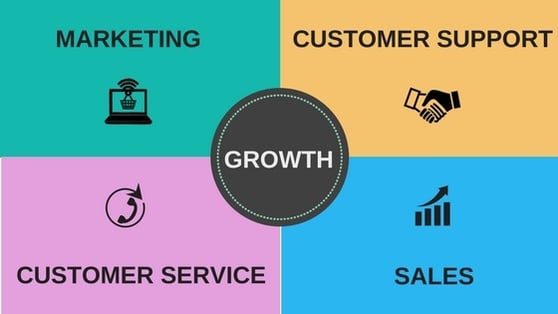The success of businesses is intertwined with the success of the customers. The more success your customers get out of your product or service, the more successful your business will be. Customer success is about proactively retaining customers, strengthening those relationships and ensuring their desired goal or outcome is achieved from using your product or service.
Customer success as a function is not just customer support or customer service, which is relatively reactive. It’s a combination of marketing, sales, customer support and customer service. Customer success, the growth machine of a business, helps customers get significant value out of the business’s product or service.
But, why is customer success key to business growth and what customer success metrics should you be measuring?
Why customer success is key to business growth
For a business to achieve on-going sustainable growth, your overarching business goals need to be align with your customer’s goals.
This ensures that the various business functions - from product to marketing - are working towards achieving the unified goal, which inherently will creating a more positive and memorable experience for your customers.
One of the biggest problems that plague many companies is a misalignment with internal team goals. When this is the case, misalignment with the customers’ needs is all but inevitable."
- Entrepreneur
As Elon Musk explained using the analogy of vectors to Dharmesh Shah, founder of HubSpot - "When every function of your business is working in alignment with each other, your business can grow faster. Read more on Entrepreneur Magazine.
Before identifying customer success milestones and choosing the metrics you want to measure against, you need to identify your customer’s goals and learn what success looks like for them. This vital piece of information - that can make or break your business growth - should be collected from the very first call or meeting.
Here are some questions recommended by Sixteen Ventures for you to ask to gain insights into how your customers define their own success:
- What is their Desired Outcome?
- How do they measure success themselves?
- How are they measured by their boss?
- What are they trying to achieve with your product?
Once you have discovered your customer’s pain points, goals and how they measure success measure. You can then break their goals into customer success milestones that both you and the customer can work towards.
This can help ensure that everyone is working towards the one goal and measuring against the appropriate customer success metrics.
While your metrics may differ depending on factors such as industry, B2B or B2C and type of projects, there are customer success metrics that nonetheless can be applicable to your business.
3 customer success metrics you should be measuring
Metric 1: Product usage and adoption
Tracking and measuring your product usage and adoption is important to measure how engaged customers are with your product and whether your customers are getting enough value out of the product. This metric is concerned with what customers are doing.
Depending on your type of industry and business product/service offerings, here are some of quantitative ways businesses can measure product usage and adoption, recommended by Groove:
- Sessions per day
- Free to paid conversion rates
- Number of downloads
- The ratio of daily active users to monthly active users (DAU/MAU ratio)
Metric 2: Monthly Recurring Revenue (MRR)
Monthly Recurring Revenue (MRR) is one of the most commonly measured metric, especially for Saas businesses. This metric is concerned with what customers are doing.
For more accurate MRR tracking, SaaS Metrics recommends breaking MRR into various types:
- Expansion MRR, generally managed by Customer Success
- New customer MRR, generally managed by Sales
- Churn MRR
- Overall MRR Growth/Net New MRR
Expansion MRR is the total new revenue from your existing customers for a given month divided by the total revenue you ended with the month before. This new revenue includes revenue from upselling and cross-sells. For example, if your new revenue totaled to $100 this month and your ending total MRR last month was $1000, your expansion revenue for this month is 10%.
New customer MRR is the total revenue from new customers for a given month.
Churn MRR is the total revenue lost from cancellations or downgrading of plans for a given month.
Overall MRR Growth/Net New MRR is New MRR + Expansion MRR – Churn MRR
For a deep dive into MRR and how businesses can reduce churn rates and increase MRR, read this article by Chargify.
Metric 3: Net Promoter Score (NPS)
Net Promoter Score (NPS) is a benchmark for customer sentiment and qualitative feedback and an important indicator of customer health and loyalty.
NPS is also dependent on how aligned your business goals are with your customer’s goals and how well you know their future goals. This metric is concerned with what customers are feeling.
The reliability of your NPS depends on high response rates and the willingness of your customers to provide honest and transparent feedback. Read this article by Typeform and AskNicely to create simple yet engaging customer satisfaction surveys.
Once you have your NPS scores, it is recommended to categorise the NPS scores into 3 parts:
- 0 - 6 = detractors
- 7 or 8 = passives
- 9 or 10 = promoters
To measure NPS, subtract the percentage of detractors from the percentage of promoters.
Depending on the size of your business, you might want to invest in customer success software technology like AskNicely that will collect data to help you identify commonalities in detractors, passives and promoters, take proactive actions to avoid attracting detractors and find more promoters, set up automatic notifications to remind you to take certain actions, and build different automated workflows to drive upgrades, retention and reviews. See HubSpot integration with AskNicely in action here.
If customer loyalty is the heartbeat of your company, NPS is your stethoscope. It lets you know who your loyal followers are, who’s complacently content, and who’s sucking the nutrients out of your brand."
- Typeform
Remember that each metric represents success in different areas of the business so it’s important to use all the metrics and data available to build a holistic customer success story.
Focusing too much on one metric can paint an incorrect picture of your customer’s health and level of success with your business. Keep your business goals and plans aligned with your customer’s success and your business will grow, in due time!
Tags:
Marketing + Automation
December 7, 2017

